Fever and Antibiotics in the Management of Infection
VerifiedAdded on 2019/11/12
|5
|1814
|193
Report
AI Summary
The case study discusses Mary's wound infection caused by Staphylococcus aureus, which was treated with Augmentin, an oral antibiotic. The development of fever is also explained as a response to the immune system, triggering the release of cytokines that cause a rise in body temperature. Fever has benefits such as stopping bacterial multiplication and promoting phagocytosis. Additionally, the assignment highlights the importance of proper hand hygiene in preventing endogenous infections like Mary's. Augmentin was prescribed because it is effective against antibiotic-resistant Staphylococcus aureus strains, which was confirmed by the wound swab report.
Contribute Materials
Your contribution can guide someone’s learning journey. Share your
documents today.
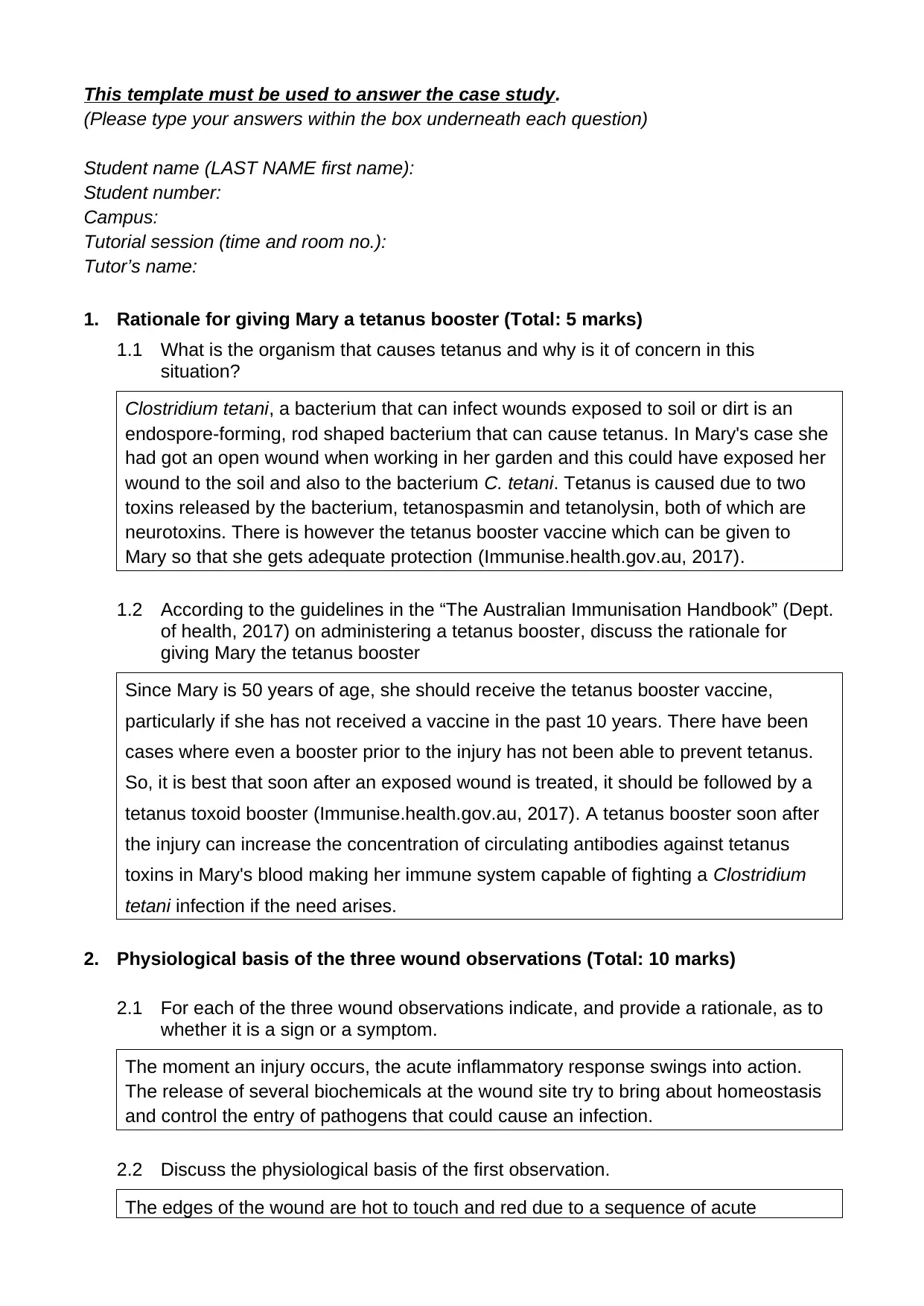
This template must be used to answer the case study.
(Please type your answers within the box underneath each question)
Student name (LAST NAME first name):
Student number:
Campus:
Tutorial session (time and room no.):
Tutor’s name:
1. Rationale for giving Mary a tetanus booster (Total: 5 marks)
1.1 What is the organism that causes tetanus and why is it of concern in this
situation?
Clostridium tetani, a bacterium that can infect wounds exposed to soil or dirt is an
endospore-forming, rod shaped bacterium that can cause tetanus. In Mary's case she
had got an open wound when working in her garden and this could have exposed her
wound to the soil and also to the bacterium C. tetani. Tetanus is caused due to two
toxins released by the bacterium, tetanospasmin and tetanolysin, both of which are
neurotoxins. There is however the tetanus booster vaccine which can be given to
Mary so that she gets adequate protection (Immunise.health.gov.au, 2017).
1.2 According to the guidelines in the “The Australian Immunisation Handbook” (Dept.
of health, 2017) on administering a tetanus booster, discuss the rationale for
giving Mary the tetanus booster
Since Mary is 50 years of age, she should receive the tetanus booster vaccine,
particularly if she has not received a vaccine in the past 10 years. There have been
cases where even a booster prior to the injury has not been able to prevent tetanus.
So, it is best that soon after an exposed wound is treated, it should be followed by a
tetanus toxoid booster (Immunise.health.gov.au, 2017). A tetanus booster soon after
the injury can increase the concentration of circulating antibodies against tetanus
toxins in Mary's blood making her immune system capable of fighting a Clostridium
tetani infection if the need arises.
2. Physiological basis of the three wound observations (Total: 10 marks)
2.1 For each of the three wound observations indicate, and provide a rationale, as to
whether it is a sign or a symptom.
The moment an injury occurs, the acute inflammatory response swings into action.
The release of several biochemicals at the wound site try to bring about homeostasis
and control the entry of pathogens that could cause an infection.
2.2 Discuss the physiological basis of the first observation.
The edges of the wound are hot to touch and red due to a sequence of acute
(Please type your answers within the box underneath each question)
Student name (LAST NAME first name):
Student number:
Campus:
Tutorial session (time and room no.):
Tutor’s name:
1. Rationale for giving Mary a tetanus booster (Total: 5 marks)
1.1 What is the organism that causes tetanus and why is it of concern in this
situation?
Clostridium tetani, a bacterium that can infect wounds exposed to soil or dirt is an
endospore-forming, rod shaped bacterium that can cause tetanus. In Mary's case she
had got an open wound when working in her garden and this could have exposed her
wound to the soil and also to the bacterium C. tetani. Tetanus is caused due to two
toxins released by the bacterium, tetanospasmin and tetanolysin, both of which are
neurotoxins. There is however the tetanus booster vaccine which can be given to
Mary so that she gets adequate protection (Immunise.health.gov.au, 2017).
1.2 According to the guidelines in the “The Australian Immunisation Handbook” (Dept.
of health, 2017) on administering a tetanus booster, discuss the rationale for
giving Mary the tetanus booster
Since Mary is 50 years of age, she should receive the tetanus booster vaccine,
particularly if she has not received a vaccine in the past 10 years. There have been
cases where even a booster prior to the injury has not been able to prevent tetanus.
So, it is best that soon after an exposed wound is treated, it should be followed by a
tetanus toxoid booster (Immunise.health.gov.au, 2017). A tetanus booster soon after
the injury can increase the concentration of circulating antibodies against tetanus
toxins in Mary's blood making her immune system capable of fighting a Clostridium
tetani infection if the need arises.
2. Physiological basis of the three wound observations (Total: 10 marks)
2.1 For each of the three wound observations indicate, and provide a rationale, as to
whether it is a sign or a symptom.
The moment an injury occurs, the acute inflammatory response swings into action.
The release of several biochemicals at the wound site try to bring about homeostasis
and control the entry of pathogens that could cause an infection.
2.2 Discuss the physiological basis of the first observation.
The edges of the wound are hot to touch and red due to a sequence of acute
Secure Best Marks with AI Grader
Need help grading? Try our AI Grader for instant feedback on your assignments.
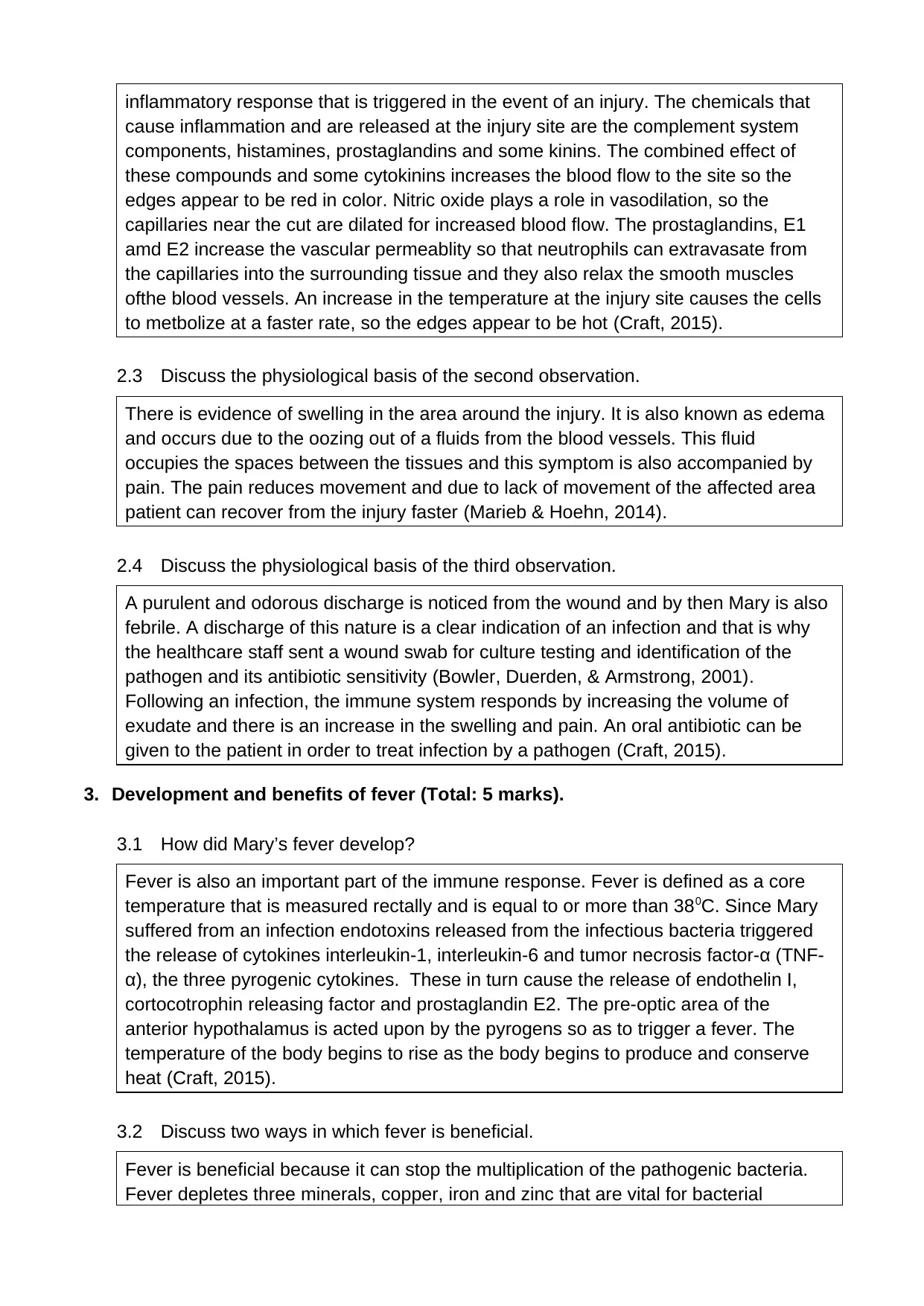
inflammatory response that is triggered in the event of an injury. The chemicals that
cause inflammation and are released at the injury site are the complement system
components, histamines, prostaglandins and some kinins. The combined effect of
these compounds and some cytokinins increases the blood flow to the site so the
edges appear to be red in color. Nitric oxide plays a role in vasodilation, so the
capillaries near the cut are dilated for increased blood flow. The prostaglandins, E1
amd E2 increase the vascular permeablity so that neutrophils can extravasate from
the capillaries into the surrounding tissue and they also relax the smooth muscles
ofthe blood vessels. An increase in the temperature at the injury site causes the cells
to metbolize at a faster rate, so the edges appear to be hot (Craft, 2015).
2.3 Discuss the physiological basis of the second observation.
There is evidence of swelling in the area around the injury. It is also known as edema
and occurs due to the oozing out of a fluids from the blood vessels. This fluid
occupies the spaces between the tissues and this symptom is also accompanied by
pain. The pain reduces movement and due to lack of movement of the affected area
patient can recover from the injury faster (Marieb & Hoehn, 2014).
2.4 Discuss the physiological basis of the third observation.
A purulent and odorous discharge is noticed from the wound and by then Mary is also
febrile. A discharge of this nature is a clear indication of an infection and that is why
the healthcare staff sent a wound swab for culture testing and identification of the
pathogen and its antibiotic sensitivity (Bowler, Duerden, & Armstrong, 2001).
Following an infection, the immune system responds by increasing the volume of
exudate and there is an increase in the swelling and pain. An oral antibiotic can be
given to the patient in order to treat infection by a pathogen (Craft, 2015).
3. Development and benefits of fever (Total: 5 marks).
3.1 How did Mary’s fever develop?
Fever is also an important part of the immune response. Fever is defined as a core
temperature that is measured rectally and is equal to or more than 380C. Since Mary
suffered from an infection endotoxins released from the infectious bacteria triggered
the release of cytokines interleukin-1, interleukin-6 and tumor necrosis factor-α (TNF-
α), the three pyrogenic cytokines. These in turn cause the release of endothelin I,
cortocotrophin releasing factor and prostaglandin E2. The pre-optic area of the
anterior hypothalamus is acted upon by the pyrogens so as to trigger a fever. The
temperature of the body begins to rise as the body begins to produce and conserve
heat (Craft, 2015).
3.2 Discuss two ways in which fever is beneficial.
Fever is beneficial because it can stop the multiplication of the pathogenic bacteria.
Fever depletes three minerals, copper, iron and zinc that are vital for bacterial
cause inflammation and are released at the injury site are the complement system
components, histamines, prostaglandins and some kinins. The combined effect of
these compounds and some cytokinins increases the blood flow to the site so the
edges appear to be red in color. Nitric oxide plays a role in vasodilation, so the
capillaries near the cut are dilated for increased blood flow. The prostaglandins, E1
amd E2 increase the vascular permeablity so that neutrophils can extravasate from
the capillaries into the surrounding tissue and they also relax the smooth muscles
ofthe blood vessels. An increase in the temperature at the injury site causes the cells
to metbolize at a faster rate, so the edges appear to be hot (Craft, 2015).
2.3 Discuss the physiological basis of the second observation.
There is evidence of swelling in the area around the injury. It is also known as edema
and occurs due to the oozing out of a fluids from the blood vessels. This fluid
occupies the spaces between the tissues and this symptom is also accompanied by
pain. The pain reduces movement and due to lack of movement of the affected area
patient can recover from the injury faster (Marieb & Hoehn, 2014).
2.4 Discuss the physiological basis of the third observation.
A purulent and odorous discharge is noticed from the wound and by then Mary is also
febrile. A discharge of this nature is a clear indication of an infection and that is why
the healthcare staff sent a wound swab for culture testing and identification of the
pathogen and its antibiotic sensitivity (Bowler, Duerden, & Armstrong, 2001).
Following an infection, the immune system responds by increasing the volume of
exudate and there is an increase in the swelling and pain. An oral antibiotic can be
given to the patient in order to treat infection by a pathogen (Craft, 2015).
3. Development and benefits of fever (Total: 5 marks).
3.1 How did Mary’s fever develop?
Fever is also an important part of the immune response. Fever is defined as a core
temperature that is measured rectally and is equal to or more than 380C. Since Mary
suffered from an infection endotoxins released from the infectious bacteria triggered
the release of cytokines interleukin-1, interleukin-6 and tumor necrosis factor-α (TNF-
α), the three pyrogenic cytokines. These in turn cause the release of endothelin I,
cortocotrophin releasing factor and prostaglandin E2. The pre-optic area of the
anterior hypothalamus is acted upon by the pyrogens so as to trigger a fever. The
temperature of the body begins to rise as the body begins to produce and conserve
heat (Craft, 2015).
3.2 Discuss two ways in which fever is beneficial.
Fever is beneficial because it can stop the multiplication of the pathogenic bacteria.
Fever depletes three minerals, copper, iron and zinc that are vital for bacterial
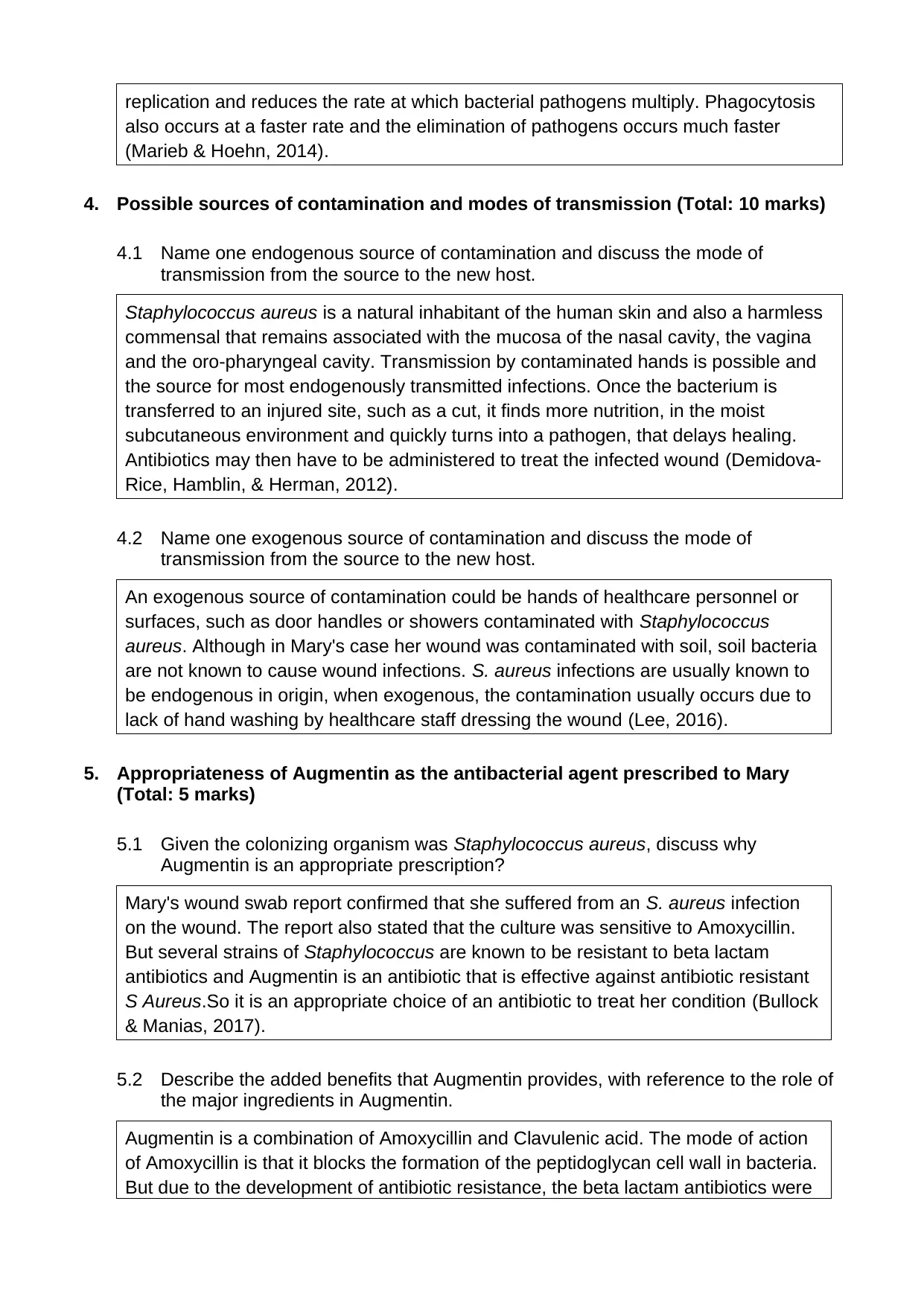
replication and reduces the rate at which bacterial pathogens multiply. Phagocytosis
also occurs at a faster rate and the elimination of pathogens occurs much faster
(Marieb & Hoehn, 2014).
4. Possible sources of contamination and modes of transmission (Total: 10 marks)
4.1 Name one endogenous source of contamination and discuss the mode of
transmission from the source to the new host.
Staphylococcus aureus is a natural inhabitant of the human skin and also a harmless
commensal that remains associated with the mucosa of the nasal cavity, the vagina
and the oro-pharyngeal cavity. Transmission by contaminated hands is possible and
the source for most endogenously transmitted infections. Once the bacterium is
transferred to an injured site, such as a cut, it finds more nutrition, in the moist
subcutaneous environment and quickly turns into a pathogen, that delays healing.
Antibiotics may then have to be administered to treat the infected wound (Demidova-
Rice, Hamblin, & Herman, 2012).
4.2 Name one exogenous source of contamination and discuss the mode of
transmission from the source to the new host.
An exogenous source of contamination could be hands of healthcare personnel or
surfaces, such as door handles or showers contaminated with Staphylococcus
aureus. Although in Mary's case her wound was contaminated with soil, soil bacteria
are not known to cause wound infections. S. aureus infections are usually known to
be endogenous in origin, when exogenous, the contamination usually occurs due to
lack of hand washing by healthcare staff dressing the wound (Lee, 2016).
5. Appropriateness of Augmentin as the antibacterial agent prescribed to Mary
(Total: 5 marks)
5.1 Given the colonizing organism was Staphylococcus aureus, discuss why
Augmentin is an appropriate prescription?
Mary's wound swab report confirmed that she suffered from an S. aureus infection
on the wound. The report also stated that the culture was sensitive to Amoxycillin.
But several strains of Staphylococcus are known to be resistant to beta lactam
antibiotics and Augmentin is an antibiotic that is effective against antibiotic resistant
S Aureus.So it is an appropriate choice of an antibiotic to treat her condition (Bullock
& Manias, 2017).
5.2 Describe the added benefits that Augmentin provides, with reference to the role of
the major ingredients in Augmentin.
Augmentin is a combination of Amoxycillin and Clavulenic acid. The mode of action
of Amoxycillin is that it blocks the formation of the peptidoglycan cell wall in bacteria.
But due to the development of antibiotic resistance, the beta lactam antibiotics were
also occurs at a faster rate and the elimination of pathogens occurs much faster
(Marieb & Hoehn, 2014).
4. Possible sources of contamination and modes of transmission (Total: 10 marks)
4.1 Name one endogenous source of contamination and discuss the mode of
transmission from the source to the new host.
Staphylococcus aureus is a natural inhabitant of the human skin and also a harmless
commensal that remains associated with the mucosa of the nasal cavity, the vagina
and the oro-pharyngeal cavity. Transmission by contaminated hands is possible and
the source for most endogenously transmitted infections. Once the bacterium is
transferred to an injured site, such as a cut, it finds more nutrition, in the moist
subcutaneous environment and quickly turns into a pathogen, that delays healing.
Antibiotics may then have to be administered to treat the infected wound (Demidova-
Rice, Hamblin, & Herman, 2012).
4.2 Name one exogenous source of contamination and discuss the mode of
transmission from the source to the new host.
An exogenous source of contamination could be hands of healthcare personnel or
surfaces, such as door handles or showers contaminated with Staphylococcus
aureus. Although in Mary's case her wound was contaminated with soil, soil bacteria
are not known to cause wound infections. S. aureus infections are usually known to
be endogenous in origin, when exogenous, the contamination usually occurs due to
lack of hand washing by healthcare staff dressing the wound (Lee, 2016).
5. Appropriateness of Augmentin as the antibacterial agent prescribed to Mary
(Total: 5 marks)
5.1 Given the colonizing organism was Staphylococcus aureus, discuss why
Augmentin is an appropriate prescription?
Mary's wound swab report confirmed that she suffered from an S. aureus infection
on the wound. The report also stated that the culture was sensitive to Amoxycillin.
But several strains of Staphylococcus are known to be resistant to beta lactam
antibiotics and Augmentin is an antibiotic that is effective against antibiotic resistant
S Aureus.So it is an appropriate choice of an antibiotic to treat her condition (Bullock
& Manias, 2017).
5.2 Describe the added benefits that Augmentin provides, with reference to the role of
the major ingredients in Augmentin.
Augmentin is a combination of Amoxycillin and Clavulenic acid. The mode of action
of Amoxycillin is that it blocks the formation of the peptidoglycan cell wall in bacteria.
But due to the development of antibiotic resistance, the beta lactam antibiotics were
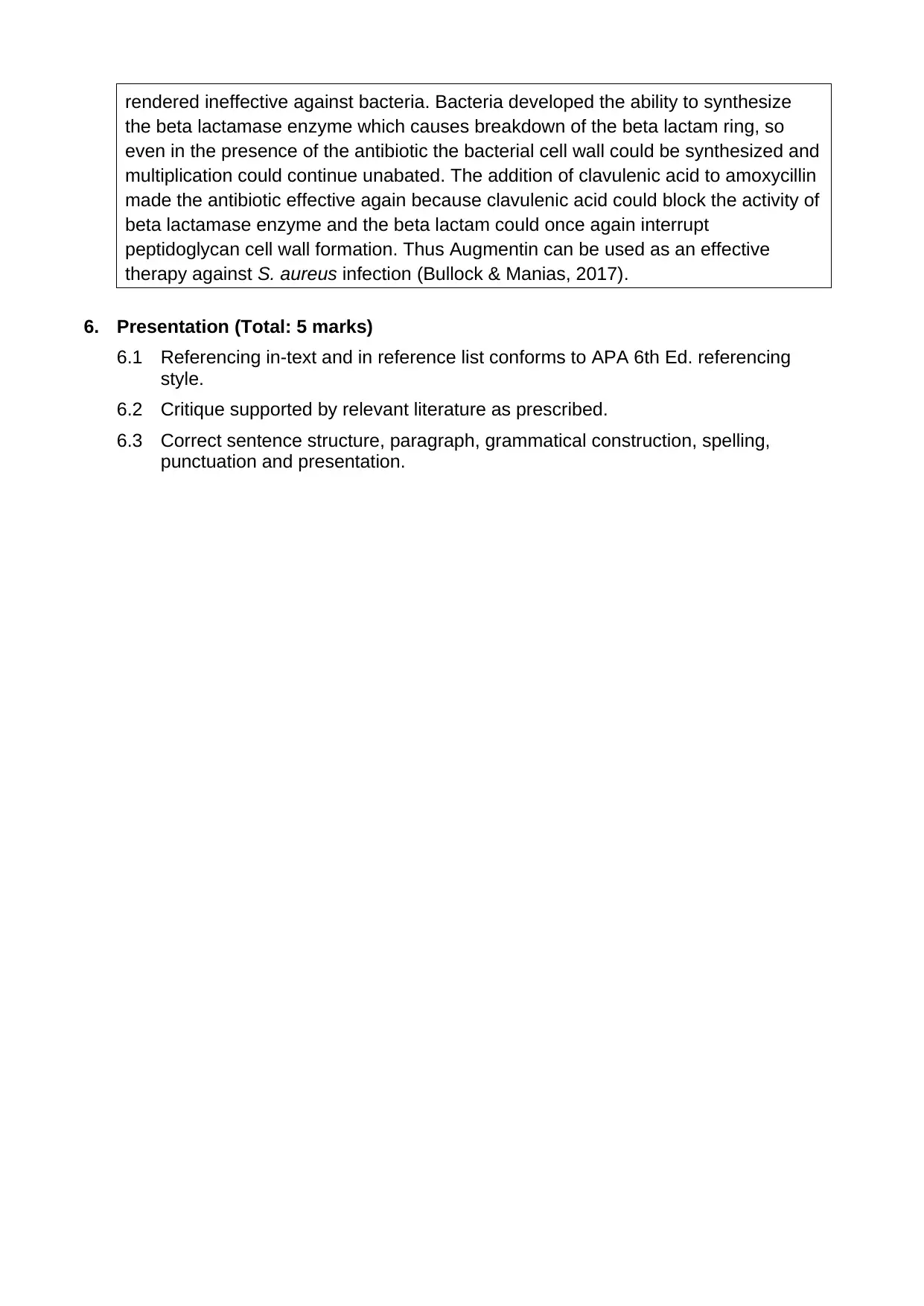
rendered ineffective against bacteria. Bacteria developed the ability to synthesize
the beta lactamase enzyme which causes breakdown of the beta lactam ring, so
even in the presence of the antibiotic the bacterial cell wall could be synthesized and
multiplication could continue unabated. The addition of clavulenic acid to amoxycillin
made the antibiotic effective again because clavulenic acid could block the activity of
beta lactamase enzyme and the beta lactam could once again interrupt
peptidoglycan cell wall formation. Thus Augmentin can be used as an effective
therapy against S. aureus infection (Bullock & Manias, 2017).
6. Presentation (Total: 5 marks)
6.1 Referencing in-text and in reference list conforms to APA 6th Ed. referencing
style.
6.2 Critique supported by relevant literature as prescribed.
6.3 Correct sentence structure, paragraph, grammatical construction, spelling,
punctuation and presentation.
the beta lactamase enzyme which causes breakdown of the beta lactam ring, so
even in the presence of the antibiotic the bacterial cell wall could be synthesized and
multiplication could continue unabated. The addition of clavulenic acid to amoxycillin
made the antibiotic effective again because clavulenic acid could block the activity of
beta lactamase enzyme and the beta lactam could once again interrupt
peptidoglycan cell wall formation. Thus Augmentin can be used as an effective
therapy against S. aureus infection (Bullock & Manias, 2017).
6. Presentation (Total: 5 marks)
6.1 Referencing in-text and in reference list conforms to APA 6th Ed. referencing
style.
6.2 Critique supported by relevant literature as prescribed.
6.3 Correct sentence structure, paragraph, grammatical construction, spelling,
punctuation and presentation.
Secure Best Marks with AI Grader
Need help grading? Try our AI Grader for instant feedback on your assignments.
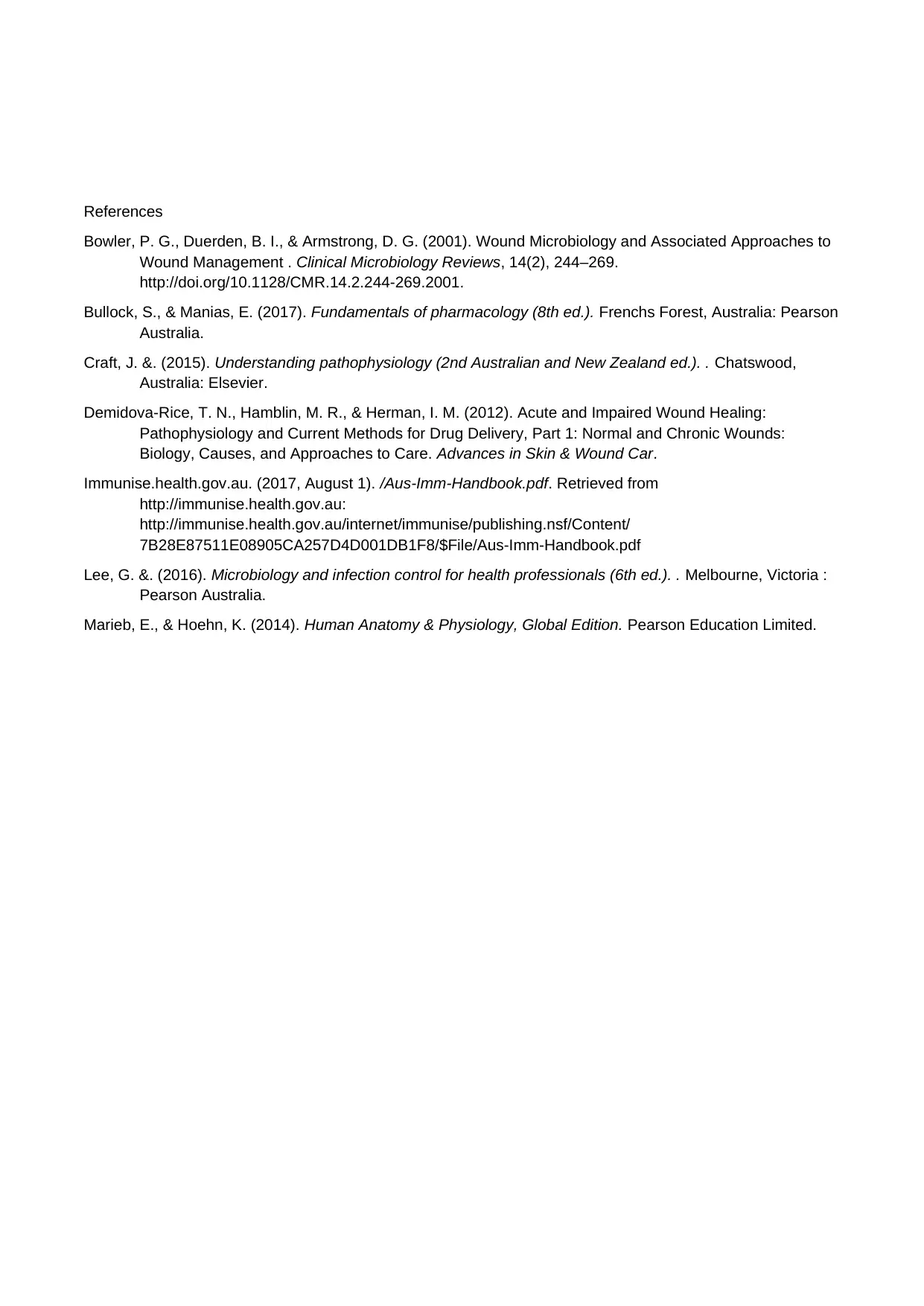
References
Bowler, P. G., Duerden, B. I., & Armstrong, D. G. (2001). Wound Microbiology and Associated Approaches to
Wound Management . Clinical Microbiology Reviews, 14(2), 244–269.
http://doi.org/10.1128/CMR.14.2.244-269.2001.
Bullock, S., & Manias, E. (2017). Fundamentals of pharmacology (8th ed.). Frenchs Forest, Australia: Pearson
Australia.
Craft, J. &. (2015). Understanding pathophysiology (2nd Australian and New Zealand ed.). . Chatswood,
Australia: Elsevier.
Demidova-Rice, T. N., Hamblin, M. R., & Herman, I. M. (2012). Acute and Impaired Wound Healing:
Pathophysiology and Current Methods for Drug Delivery, Part 1: Normal and Chronic Wounds:
Biology, Causes, and Approaches to Care. Advances in Skin & Wound Car.
Immunise.health.gov.au. (2017, August 1). /Aus-Imm-Handbook.pdf. Retrieved from
http://immunise.health.gov.au:
http://immunise.health.gov.au/internet/immunise/publishing.nsf/Content/
7B28E87511E08905CA257D4D001DB1F8/$File/Aus-Imm-Handbook.pdf
Lee, G. &. (2016). Microbiology and infection control for health professionals (6th ed.). . Melbourne, Victoria :
Pearson Australia.
Marieb, E., & Hoehn, K. (2014). Human Anatomy & Physiology, Global Edition. Pearson Education Limited.
Bowler, P. G., Duerden, B. I., & Armstrong, D. G. (2001). Wound Microbiology and Associated Approaches to
Wound Management . Clinical Microbiology Reviews, 14(2), 244–269.
http://doi.org/10.1128/CMR.14.2.244-269.2001.
Bullock, S., & Manias, E. (2017). Fundamentals of pharmacology (8th ed.). Frenchs Forest, Australia: Pearson
Australia.
Craft, J. &. (2015). Understanding pathophysiology (2nd Australian and New Zealand ed.). . Chatswood,
Australia: Elsevier.
Demidova-Rice, T. N., Hamblin, M. R., & Herman, I. M. (2012). Acute and Impaired Wound Healing:
Pathophysiology and Current Methods for Drug Delivery, Part 1: Normal and Chronic Wounds:
Biology, Causes, and Approaches to Care. Advances in Skin & Wound Car.
Immunise.health.gov.au. (2017, August 1). /Aus-Imm-Handbook.pdf. Retrieved from
http://immunise.health.gov.au:
http://immunise.health.gov.au/internet/immunise/publishing.nsf/Content/
7B28E87511E08905CA257D4D001DB1F8/$File/Aus-Imm-Handbook.pdf
Lee, G. &. (2016). Microbiology and infection control for health professionals (6th ed.). . Melbourne, Victoria :
Pearson Australia.
Marieb, E., & Hoehn, K. (2014). Human Anatomy & Physiology, Global Edition. Pearson Education Limited.
1 out of 5
Related Documents
Your All-in-One AI-Powered Toolkit for Academic Success.
+13062052269
info@desklib.com
Available 24*7 on WhatsApp / Email
![[object Object]](/_next/static/media/star-bottom.7253800d.svg)
Unlock your academic potential
© 2024 | Zucol Services PVT LTD | All rights reserved.





